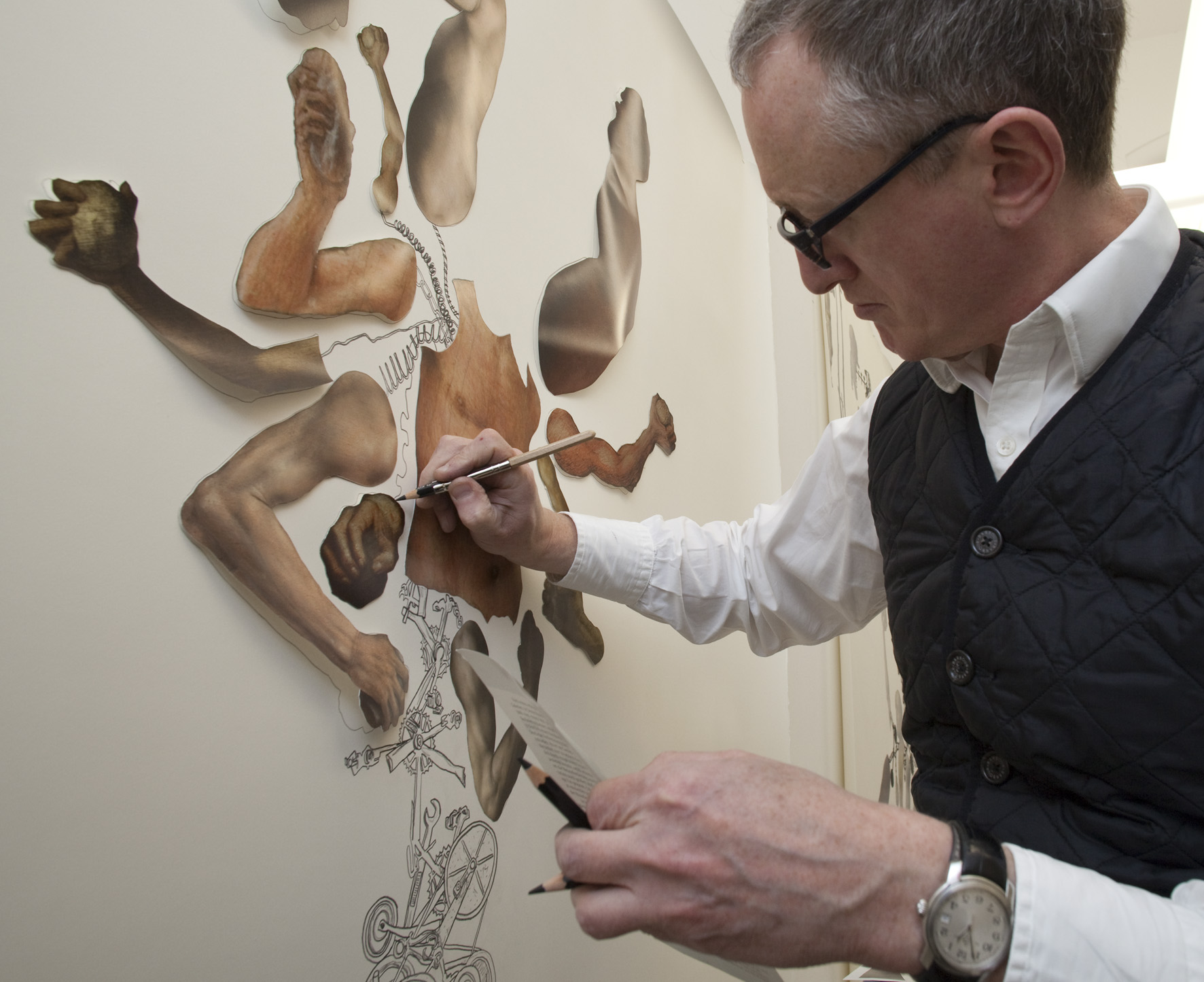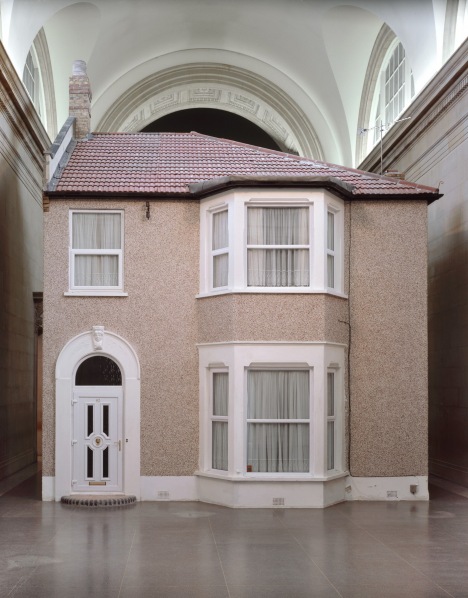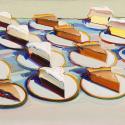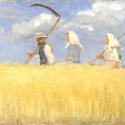Much of Michael Landy’s work concerns destruction or decay. The British artist, who recently turned 50 and is part of the YBA generation, came to prominence in 2001 with the Artangel commission Break Down, which saw all his worldly possessions destroyed in an industrial shredder. His next project saw him scale right down, surprising everyone with an exhibition of beautifully executed drawings of weeds.
Landy’s love of close observational drawing continued with a series of arresting portraits. But then we saw the cathartic destruction of Art Bin, in 2010, where he'd invited members of the public to throw away their unwanted art works. The huge bin at the South London Gallery rapidly filled up with unloved art, ready for the shredders.
His National Gallery exhibition Saints Alive opens this week, the culmination of a two-year residency in which he responds to the gallery's collection of paintings of saints, from Lucas Cranach the Elder's Saint Apollonia to Botticelli's Saint Francis of Assisi.
My saints beat themselves up and bits fall off them. I liked the idea of the saints being like junk in a sense, like the weeds
FISUN GÜNER: You’d never visited the National Gallery collection before getting your residency. What’s it like coming to the collection completely fresh, after practising as an artist for so long?
MICHAEL LANDY: I'd meant I’d entered the building before, but I hadn’t really…
You’d gone to the café…
Yeah, I’d gone to the loo, and eaten some cakes. You don’t really engage with the collection until you start making work about it. Or until someone asks you to become artist-in-residence. And then you think, “Oh Christ.” So I wandered around here for about a year thinking “Oh God, why me? I’m rubbish…” I met up with Colin Wiggins (National Gallery’s Head of Education) after I got the call, just to make sure someone wasn’t pulling my leg.
Why where you drawn to the saints?
I didn’t know the collection, so one of the first things I noticed when I wandered around was how many saints there were. I wanted to know more about saints so I started to read The Golden Legend (a collection of medieval hagiographies by Jacobus de Voragine). I got drawn into the stories.
You could have gone for a nice Madonna and Child theme…
I did think about babies – babies just repeated all over the walls, like a wallpaper of babies, like Warhol’s cows. That did cross my mind at first, but it kind of stopped there. Then the other thing I thought of was this humungous Saint Catherine’s wheel rolling through the galleries, as that’s her wheel of torture.
Are you religious?
I’ve just turned 50 so I’m not going to dismiss it out of hand…um, I don’t know really. Sometimes I go past a church and think, “Ah, that’s some nice solitude – I can go in there for a while.” I think maybe it’s because they’re quiet places and people can contemplate things. Obviously the paintings upstairs were commissioned for religious devotion and then they ended up in an art gallery. I see them very much as art works, but I understand that other people will see them as primarily religious icons.
But you were bought up a Catholic.
The imagery is kind of familiar, the imagery of suffering. My saints aren’t saints who do good deeds, like Saint Nicholas – they’re virgin martyrs, and people like Saint Catherine, who refused to worship the emperor’s pagan gods, so she has her head chopped off. I didn’t do any happy saints. They’ve all got sores in their heads, or they’ve had their heads chopped off, or they’re beating themselves with rocks. We’ve got replacement parts, but I sense it might be a junk heap at the end, though I’m hoping it won’t be.
Were you thinking of Hieronymus Bosch when you started to think of your sculptures? That’s who I’m reminded of a little when I see the work.
No, I don’t think so. I was thinking more of Jean Tinguely, his kinetic sculptures from the 1970s. I kind of wanted to fuse these two things, the saints from the collection, and the idea that they can move. I wanted the saints to come alive and I wanted to engage the public in a different way to how they engage with paintings. So I thought, Jean Tinguely, kinetic art, 1982, the Tate, and me as an 18 year old. I wanted to do something similar to that, but using body parts from the saints.
Tinguely obviously made a profound impression on you when you were still a teenager. Is he why you wanted to become an artist?
No, I became an artist because I could draw relatively well when I was a child, but I loved the exhibition in 1982. When you flip through lots of Tinguely catalogues there are always people touching them, coming away with Meta-Matic drawings (drawings created by a Tinguely drawing machine) and laughing and smiling. As you put your foot on the foot pedal these bits of junk do a pogo...or not – sometimes they didn’t work at all. I absolutely loved it.
I think the new work will really surprise people. People were surprised when you did the drawing of weeds after Break Down, for instance. They thought that was a really surprising thing to do, because they associated you with a huge conceptual project. And now you’ve done this. You’ve been incredibly diverse throughout your career.
 Well, yes, I guess, but there are kinds of similarities…I mean, my saints beat themselves up and bits fall off them, so they have destructive elements to them and I liked the idea of the saints being like junk in a sense, like the weeds. They’ve been junked, we’ve forgotten about them, and then I’ve come along, like Tinguely does, and rediscovered them and put them back together again.
Well, yes, I guess, but there are kinds of similarities…I mean, my saints beat themselves up and bits fall off them, so they have destructive elements to them and I liked the idea of the saints being like junk in a sense, like the weeds. They’ve been junked, we’ve forgotten about them, and then I’ve come along, like Tinguely does, and rediscovered them and put them back together again.
Yes, there’s a running theme of destruction and decay in most of your work. The only thing that’s a departure from that is your parent’s house, which you replicated for a Tate Britian exhibition. That’s the one point of stability, which I find interesting.
Well, I did Acts of Kindness on the London Underground where I asked people to send in their stories of everyday acts of kindness. So I like the everyday, and my parent’s house was just like the normal house in a street you’d walk past. It’s not exceptional in any possible way.
How close to your parent's house was it? (Pictured below: Semi-Detached, 2004, Tate Britain.)
 It was 1:1 in scale, so yes, very. In the Tate there was just enough space to walk round either side of it. People would actually drive to my parent’s house and look at it and take pictures of it and knock on the door. I didn’t realise that The Telegraph would literally go round and doorstep my mum and dad. It hadn’t even dawned on me that people would want to see the original house in its original setting, but it became a bit of an attraction for a while.
It was 1:1 in scale, so yes, very. In the Tate there was just enough space to walk round either side of it. People would actually drive to my parent’s house and look at it and take pictures of it and knock on the door. I didn’t realise that The Telegraph would literally go round and doorstep my mum and dad. It hadn’t even dawned on me that people would want to see the original house in its original setting, but it became a bit of an attraction for a while.
That must have been an extremely strange experience.
Yeah, it was. I used to like driving past the Tate when it was shut, and thinking, “Oh, my mum and dad’s house is in there.” But actually, it was more strange becoming an artist-in-residence round at my mum and dad’s house when I was actually doing the project, because I hadn’t really spent much time round there. Suddenly I was ensconced in there, training video cameras on my dad and drawing him and becoming a nuisance, really.
Do you still draw every day?
Not really, not every day, but I drew all the Saint Catherine wheels from the collection – there are 35 in all. It’s like a big heap of Saint Catherine wheels, and it’s a big drawing – it took me a whole month to do. But I just think, “You can’t carry on doing this, because time’s running out.” I turned 50 recently, and I feel time’s running out. When I was younger, I had all this time and I drew so much stuff. Now I think I just haven’t got the time for that any more – I’ve got to do something else. But I do like being by myself – I think that’s why I draw. I don’t have studio assistants. I like to spend vast amounts of time by myself.
In terms of looking and making you more attentive to detail, not just in terms of developing technical skills, do you think drawing has helped you as an artist?
Yeah, it made me look. I mean I drew a series of portraits of people a few years ago where I got about this close [comes up very close] looking at people’s faces. I want to draw what’s in front of me. That’s normally my prerequisite for drawing.
Do you ever feel, like Saint Francis, that you’d like to divest yourself of all your material possessions again, as you did in Break Down?
No. No, I don’t. I knew that would be the outcome but that wasn’t really why I did the project. For me, it was just about those two weeks. Saint Francis has a mystic marriage to Lady Poverty, he’s envious of people’s rags, those who are poorer than him. But in my work, I have a Saint Francis not quite doing what he’s supposed to be doing. He gives out T-shirts to the public. I’ve chopped his head off and he’s like an empty vessel with T-shirts inside. There’s a crane that comes in and gives out T-shirts which have the Franciscan vows printed on them – Poverty, Chastity and Obedience. In fact, all the sculptures are interactive. They’re all activated in one way or another.
Do you think about death a lot?
Yeah, I probably do. I got cancer about 10 years ago, and that’s the first time I really thought about my own death. I used to walk past pubs and see people laughing and having a nice time and thinking, “That used to be me”. Because when people say cancer you think you’re going to die. But I think it’s been a preoccupation for a while. All artists think about death. It’s better than thinking about cheerful subjects. We like to look at detritus, carcasses. That’s what artists like thinking about.
Well, lots of artists are preoccupied by death when they’re still quite young, when the possibility of it seems impossibly remote to them. Were you?
Probably. My mum got me a job when I was 18 working as an auxiliary nurse and that was the first time I was literally confronted with people dying. Obviously, when you’re 18 you’re in peak physical condition and suddenly you’re looking at people who are at the last stages of their lives. I would have given that job up – I didn’t realise you could give up a job at that time. It was like a summer job. It was just a really Irish Catholic thing to do, getting me a job as an auxiliary nurse when I was quite a sensitive boy. Maybe she thought it was going to harden me up, but actually, I used to think about the patients quite a lot. I became very friendly with quite a number of them. I probably wasn’t a very good nurse.
Finally, are you getting nervous about what kind of reception you'll receive for this exhibition of self-destructing saints?
No, I don’t get nervous. Once you've destroyed your underpants in front of people you don’t really get nervous.










![SEX MONEY RACE RELIGION [2016] by Gilbert and George. Installation shot of Gilbert & George 21ST CENTURY PICTURES Hayward Gallery](/sites/default/files/styles/thumbnail_125_x_125_/public/mastimages/Gilbert%20%26%20George_%2021ST%20CENTURY%20PICTURES.%20SEX%20MONEY%20RACE%20RELIGION%20%5B2016%5D.%20Photo_%20Mark%20Blower.%20Courtesy%20of%20the%20Gilbert%20%26%20George%20and%20the%20Hayward%20Gallery._0.jpg?itok=3oW-Y84i)




Add comment